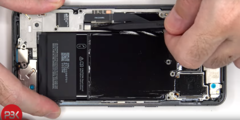 Pixel 8 Pro teardown. (Source: PBK Reviews)
Pixel 8 Pro teardown. (Source: PBK Reviews)
Concerns have been raised about the ability of the Pixel 8 Pro to manage heat following the first video teardown of the device to hit the net. As with the Pixel 7 Pro, the Pixel 8 Pro does not have a vapor chamber cooling system as found on devices like the Galaxy S23 Ultra among Android flagship phones, but relies on graphite and copper to keep things cool.
Google’s Pixel 8 Pro has been given the full teardown treatment ahead of its wider availability later this week. To date, on a select group of reviewers and YouTubers have been able to get their hands on the device, which has given users an early insight into the devices and their performance. While camera samples are impressive – which is not surprising given Google’s track record with computational photography and the upgraded camera hardware – concerns have been raised about the performance, efficiency, and stability of the Tensor G3 SoC. Given the chip was made by Samsung Foundry, this is not surprising as previous chips made on Samsung’s 4 nm nodes have been plagued by similar issues.
This has put the attention on the cooling mechanisms Google has employed in the Pixel 8 Pro to help keep things in check thermally, with all eyes on whether Google had added vapor chamber to keep things cooler after complaints of overheating were raised by Pixel 6 series owners and Pixel 7 series owners. YouTube channel PBK Reviews has provided a complete teardown of the Pixel 8 Pro, but unfortunately, Google has once again skipped vapor chamber cooling. However, it has used unusually thick layers of graphite on top of the battery and across the RAM/CPU wares, while it has also used a notably thick piece of copper tape above the RAM, which sits atop the CPU – this is also covered with additional graphite tape to spread the heat back to the chassis and larger graphite pad that sits above it.
While vapor chambers are an effective way to dissipate heat — fluid within the chamber changing states to a gas vapor and back again — they do add cost, complexity, and thickness to the design of a device. However, as Samsung’s own Galaxy S22 Ultra showed, even when fitted with vapor chamber cooling, these cannot overcome other shortcomings of devices with chips like the Samsung fabricated Exynos 2200 and Snapdragon 8 Gen 1, which become hot due to too underlying issues with inefficiency. Vapor chamber cooling can assist in aiding sustained performance, but that won’t compensate for a lack of outright performance or efficiency.
The Google Pixel 8 Pro doesn’t hit store shelves until later this week after a short pre-order period. On the plus side, the device offers an abundance of clever software-based AI features and new and improved camera features that are sure to please fans of the Pixel series. Stay tuned for our comprehensive review coming soon.
Purchase the Google Pixel 8 Pro 128GB unlocked with a bonus Pixel Watch 2 for just $999 (a saving of $349.99).

Sanjiv Sathiah – Senior Tech Writer – 1410 articles published on Notebookcheck since 2017
I have been writing about consumer technology over the past ten years, previously with the former MacNN and Electronista, and now Notebookcheck since 2017. My first computer was an Apple ][c and this sparked a passion for Apple, but also technology in general. In the past decade, I’ve become increasingly platform agnostic and love to get my hands on and explore as much technology as I can get my hand on. Whether it is Windows, Mac, iOS, Android, Linux, Nintendo, Xbox, or PlayStation, each has plenty to offer and has given me great joy exploring them all. I was drawn to writing about tech because I love learning about the latest devices and also sharing whatever insights my experience can bring to the site and its readership.
Sanjiv Sathiah, 2023-10- 9 (Update: 2023-10- 9)
>>> Read full article>>>
Copyright for syndicated content belongs to the linked Source : NotebookCheck – https://www.notebookcheck.net/Pixel-8-Pro-teardown-reveals-no-vapor-chamber-but-thicker-than-usual-graphite-copper-layers-instead.758306.0.html





























